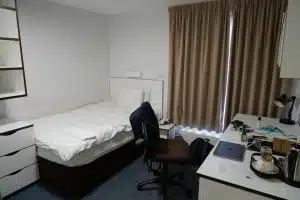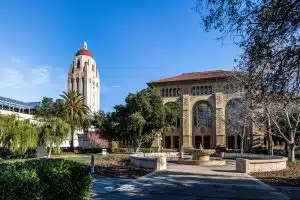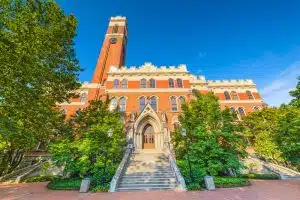Berkeley Dorm Room
Berkeley dorm room living is an integral part of the college experience, especially for those embarking on their freshman year. The University of California, Berkeley, known for its prestigious reputation, also holds a vibrant campus life that largely centers around its dormitory living.
With the academic year 2023-2024 on the horizon, there are updates and essential information about the dorm rooms that students should be abreast of. This guide aims to provide a glimpse into the dormitory life at Berkeley, covering aspects from room rates to housing applications and move-in procedures.
Rates for Academic Year 2023-2024
As a precursor to planning your college budget, understanding the housing rates is crucial. Here are the standard and premium room rates for the upcoming academic year:
Standard Room Rates
- Single: $23,205
- Double: $20,885
- Triple: $18,120
- Large Triple: $18,475
- Quad: $16,825
Premium Room Rates (Blackwell Hall)
- Single: $23,655
These rates encapsulate both housing and a meal plan, specifically the Blue Plan, ensuring students have a well-rounded dormitory experience.
Berkeley Dorm Room Dining Options
Berkeley’s meal plans offer a delightful dining experience with a variety of culinary options. The Blue Plan, included in the room rates, provides a balanced meal scheme for students. Various dining halls and on-campus eateries offer a range of cuisines, ensuring that students have nutritious and delicious meals every day.
It’s a great way to socialize and meet new friends over meals, making the dining halls a central part of the Berkeley dorm room community.
Move-In Procedures
Moving into your Berkeley dorm room is a rite of passage. The university updated the move-in information on August 4, 2023, which is filled with essential details for a smooth transition into campus life. Once assigned a room via the housing portal, students should keep an eye on their email for further updates regarding move-in procedures.
Pre-Arrival Preparations
Before you step foot on campus, there’s a checklist of tasks to complete to ensure a smooth move-in experience into your Berkeley dorm room. The first order of business is to check the housing portal for your room assignment. Familiarize yourself with the layout of the dormitory, the amenities provided, and the rules and regulations of residing in a Berkeley dorm room.
Additionally, it’s wise to connect with your future roommates. Discuss who will bring shared items such as a mini-fridge or microwave to avoid duplication. Also, talk about any preferences or concerns you might have about dorm living. This pre-arrival communication sets the stage for a harmonious living arrangement.
Packing Essentials
Packing for dorm life at Berkeley requires a balance between bringing necessary items and avoiding clutter in your new living space. Here’s a breakdown of some essentials:
- Bedding: Sheets, comforter, pillows, and mattress pad or topper.
- Personal Items: Clothing, toiletries, medications, and any other daily necessities.
- Study Materials: Books, stationery, laptop, and a reliable backpack.
- Room Accessories: Storage solutions, laundry basket, and decorations to personalize your Berkeley dorm room.
- Health and Safety Items: First-aid kit, masks, hand sanitizers, and a thermometer.
Remember, space is at a premium in dorm rooms, so pack wisely. Also, consider the weather in Berkeley throughout the year as you pack your clothing and other items.
Arrival and Check-In
Upon arrival at UC Berkeley, head to the designated check-in location mentioned in the move-in instructions. Here, you’ll receive your room keys and a welcome packet containing crucial information about living in a Berkeley dorm room, campus resources, and emergency procedures.
During check-in, you might also receive a schedule for orientation activities designed to acquaint you with the campus and your fellow dorm residents. It’s a great opportunity to mingle and create connections that could last throughout your college life and beyond.
Setting Up Your Room
The first glimpse of your Berkeley dorm room can be thrilling. As you unpack, take the time to arrange your belongings in a way that maximizes space and creates a conducive environment for both relaxation and study. If possible, coordinate with your roommates on the arrangement of furniture and shared items to ensure a comfortable living space for everyone.
Utilizing Campus Resources
UC Berkeley offers a variety of resources to help students transition into dorm life. These include:
- Orientation Events: Participate in orientation events to learn about the resources available to you as a resident of a Berkeley dorm room.
- Academic Support: Utilize the academic support centers, libraries, and study rooms to get a head start on your academic journey.
- Health and Wellness Resources: Explore the health and wellness resources available on campus to ensure you stay healthy and balanced.
- Community Building: Attend community-building events hosted by the dorm to foster a sense of belonging and build a supportive network.
Ongoing Communication
Staying informed is key to a successful dormitory experience. Regularly check your email and the housing portal for updates on dorm living, campus events, and any changes in regulations that might affect your Berkeley dorm room experience. Engage in open communication with your roommates and dormitory staff to ensure a harmonious living environment throughout the academic year.
The journey from receiving your room assignment to fully settling into your Berkeley dorm room is filled with anticipation, preparation, and adaptation. Being well-prepared and taking advantage of the resources provided by UC Berkeley can make your dormitory experience enjoyable and fulfilling.
Housing Application Deadlines
Berkeley dorm room assignments require an application well ahead of the desired move-in date. For the academic year 2023-2024, the deadlines are as follows:
- Continuing Students: February 15
- First-Year Students / Fall Program for First Semester Students: May 2
- Fall Transfers: June 2
- Spring 2024: October 1 (for graduate students)
Ensuring to adhere to these deadlines is paramount to securing a desired dorm room.
Residence Halls Overview
The Berkeley dorm room experience is significantly shaped by the diverse residence halls available on campus. Each residence hall has a unique ambiance and fosters a distinctive community that contributes to the holistic Berkeley experience. Let’s delve deeper into the offerings of some of these halls to give you a clearer picture of what to expect.
Martinez Commons
Located merely two blocks south of the main campus, Martinez Commons is a prime choice for sophomores, transfers, and upper-division students. The proximity to the academic buildings makes it a convenient option, reducing the commute time and allowing more room for other campus engagements.
- Community Atmosphere: The all-gender floors with shared bathrooms and living spaces encourage interaction and community building. The shared spaces are designed to foster collaboration and camaraderie among residents, paving the way for lasting friendships and a robust support system during your time at Berkeley.
- Amenities: Residents enjoy a range of amenities including laundry facilities, study rooms, and common areas equipped with comfortable seating and recreational options. These amenities contribute to a conducive living and learning environment, making the Berkeley dorm room experience in Martinez Commons enriching.
- Safety and Security: Safety is a priority with secure access controls in place. The live-in staff and Resident Assistants are always available to ensure a safe and supportive environment.
Unit 1
This high-rise complex is another notable residence hall that embodies a community-centric atmosphere. It’s particularly popular among freshmen due to its vibrant community and the range of facilities it offers.
- Community Atmosphere: The communal bathrooms and shared living spaces are designed to encourage interaction among residents. Various organized events and activities further promote community engagement, helping students to acclimate to the Berkeley dorm room lifestyle.
- Amenities: Unit 1 boasts a plethora of amenities including study rooms, music practice rooms, and a dining commons where students can enjoy meals together. The presence of academic and meeting spaces within the complex encourages collaborative learning and interaction beyond the classrooms.
- Safety and Security: Like Martinez Commons, Unit 1 has secure access controls and live-in staff ensuring the safety and well-being of its residents. The hall also has a mail services hub, making it easy for students to receive parcels and letters.
Blackwell Hall
A premium housing option, Blackwell Hall offers a more upscale Berkeley dorm room experience. The single rooms available here are part of the premium room rates, reflecting the superior amenities and facilities available to residents.
- Community Atmosphere: Blackwell Hall offers a more private living experience while still fostering a sense of community through shared spaces and organized events.
- Amenities: The hall boasts modern amenities including air conditioning, private bathrooms, and a state-of-the-art fitness center. The study lounges on each floor provide serene spots for focused academic work.
- Safety and Security: With secure access controls and a 24-hour front desk service, safety is well-maintained in Blackwell Hall. The hall also offers bike storage, making it a convenient choice for those who prefer a sustainable mode of transport around campus.
Each residence hall at UC Berkeley has its unique charm and set of advantages. Your choice would depend on your personal preferences, be it the bustling community of Unit 1, the convenient location of Martinez Commons, or the upscale living in Blackwell Hall. The Berkeley dorm room experience is as diverse as the university’s academic offerings, ensuring that every student finds a place they can call home during their college journey.
Berkeley Dorm Room Types and Features
The University of California, Berkeley, presents a multitude of Berkeley dorm room types, each uniquely designed to cater to the varying preferences and requirements of the students. The institution comprehends the significance of a comfortable and conducive living environment, and its diverse dorm room options exemplify this understanding.
The array of room types ensures that every student finds a living space that resonates with their lifestyle and academic needs. The following are the distinct types of dorm rooms you’ll find in Berkeley, along with the features they offer.
Traditional Dorm Rooms
Traditional dorm rooms are the quintessence of college living. These rooms usually come as singles or doubles, providing a choice for those who prefer solitude or a shared living experience. The simplicity and functionality of traditional dorm rooms make them a favorable choice for many.
They are equipped with essential furniture including a bed, desk, chair, and dresser, providing a conducive environment for both relaxation and study. The communal aspect extends to shared bathrooms and common lounges, fostering a sense of community among residents. The design of these rooms typically encourages interaction and engagement among students, forming lifelong friendships and enriching the college experience.
Suite-Style Rooms
For those seeking a blend of privacy and community, suite-style rooms are an ideal choice. These rooms house a small number of students together in a suite with shared living spaces like a common room, and in some cases, a small kitchenette. Each student has a private bedroom, which provides the needed solitude for focused study or rest.
The shared living area is a space for social interaction, collaborative learning, and forming a tight-knit suite community. The blend of private and shared spaces in suite-style Berkeley dorm rooms exemplifies a balanced college living experience.
Co-op Housing
Berkeley dorm room options extend beyond traditional halls to cooperative (co-op) housing. This type of housing is student-run and fosters a strong sense of community and shared responsibility. Residents share chores, meals, and governance, learning invaluable life skills in the process. Each co-op house has its unique personality, traditions, and events, making it an exciting and enriching living option.
Apartment-Style Living
For students seeking a more independent living arrangement, apartment-style dorm rooms are an excellent choice. These rooms come with a small kitchen, bathroom, and living area, providing a semblance of independent living while still being a part of the campus community. It’s a step towards a more mature living experience, with a touch of self-sufficiency. This Berkeley dorm room type is ideal for those ready to take on more personal responsibility in managing their living space.
Themed and Specialized Housing
Berkeley also offers themed and specialized housing to cater to specific interests, identities, or academic focuses. Themed housing can range from language houses to social justice themes, providing a space for like-minded individuals to live and learn together. Specialized housing includes options for international students, graduate students, or those with particular academic or personal needs.
Furnishings and Amenities
Every Berkeley dorm room is furnished to provide a comfortable living and learning environment. The basic furnishings include a bed, desk, chair, and dresser. Additionally, many residence halls offer enhanced amenities such as study lounges, communal kitchens, laundry facilities, and recreation areas.
These amenities are designed to make dormitory life convenient and enjoyable, encouraging a balanced lifestyle between academics, relaxation, and social interaction.
Technology and Connectivity
In this digital age, having reliable internet connectivity is crucial. Berkeley dorm rooms are equipped with high-speed internet access, ensuring students stay connected with their academics and the world around them. Moreover, some residence halls have tech-friendly amenities like computer labs and printing stations, facilitating seamless academic endeavors.
Accessibility Features
Berkeley is committed to inclusivity, and its dorm rooms are designed to be accessible to all students. Rooms with accessibility features for students with disabilities are available, ensuring a comfortable and supportive living environment for everyone.
The diverse Berkeley dorm room options and their distinctive features ensure that every student finds a fitting home away from home. The thoughtfully designed living spaces, coupled with a range of amenities and a supportive community, contribute to a conducive and enriching college living experience at UC Berkeley.
Winter Break Closure
It’s essential to note the dorm closure dates during the winter break. All halls, except for Martinez Commons, will close on December 16, 2023, and reopen on January 11, 2024. During this period, residing in the buildings is not allowed due to energy curtailment.
Berkeley Dorm Room Community Life
Living in a Berkeley dorm room is not just about having a place to rest, but also about immersing oneself in a lively and supportive community. The residence halls host numerous events, workshops, and social gatherings, fostering a sense of belonging among the residents. From floor dinners to study groups, there’s always something happening around. The live-in staff and resident assistants ensure a safe, inclusive, and engaging environment for everyone.
Conclusion
This comprehensive guide endeavors to equip you with a thorough understanding of your dorm room experience, ensuring that your transition to the illustrious halls of UC Berkeley is smooth, informed, and enjoyable. Embarking on this academic journey, your dorm room will not merely be a place to rest, but a canvas of self-expression, a hub of meaningful interactions, and a cornerstone for academic endeavors.
The unique blend of communal living, academic rigor, and personal space that a dorm room offers is an integral part of the holistic education that UC Berkeley prides itself on. From the moment you step into your assigned dorm room, the journey of making lifelong friends, forging lasting memories, and laying a strong academic foundation begins.
With each passing semester, the walls of your Berkeley dorm room will witness your transformation, your achievements, and the camaraderie that makes college life a cherished phase. This guide is a stepping stone towards making the most out of your Berkeley dorm room experience, opening doors to not just a prestigious education but a journey of self-discovery, growth, and enduring friendships.










































